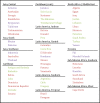Can breastfeeding promote child health equity? A comprehensive analysis of breastfeeding patterns across the developing world and what we can learn from them
- PMID: 24305597
- PMCID: PMC3896843
- DOI: 10.1186/1741-7015-11-254
Can breastfeeding promote child health equity? A comprehensive analysis of breastfeeding patterns across the developing world and what we can learn from them
Abstract
Background: In 2010 more than 7.7 million children died before their fifth birthday. Over 98% of these deaths occurred in developing countries, and recent estimates have attributed hundreds of thousands of these deaths to suboptimal breastfeeding.
Methods: This study estimated prevalence of suboptimal breastfeeding for 137 developing countries from 1990 to 2010. These estimates were compared against WHO infant feeding recommendations and combined with effect sizes from existing literature to estimate associated disease burden using a standard comparative risk assessment approach. These prevalence estimates were disaggregated by wealth quintile and linked with child mortality rates to assess how improved rates of breastfeeding may affect child health inequalities.
Results: In 2010, the prevalence of exclusive breastfeeding ranged from 3.5% in Djibouti to 77.3% in Rwanda. The proportion of child Disability Adjusted Life Years (DALYs) attributable to suboptimal breastfeeding is 7.6% at the global level and as high as 20.2% in Swaziland. Suboptimal breastfeeding is a leading childhood risk factor in all developing countries and consistently ranks higher than water and sanitation. Within most countries, breastfeeding prevalence rates do not vary considerably across wealth quintiles.
Conclusions: Breastfeeding is an effective child health intervention that does not require extensive health system infrastructure. Improvements in rates of exclusive and continued breastfeeding can contribute to the reduction of child mortality inequalities in developing countries.
Figures







Comment in
-
Simple steps to equity in child survival.BMC Med. 2013 Dec 18;11:261. doi: 10.1186/1741-7015-11-261. BMC Med. 2013. PMID: 24344755 Free PMC article.
References
-
- Lim SS, Vos T, Flaxman AD, Danaei G, Shibuya K, Adair-Rohani H, Amann M, Anderson HR, Andrews KG, Aryee M, Atkinson C, Bacchus LJ, Bahalim AN, Balakrishnan K, Balmes J, Barker-Collo S, Baxter A, Bell ML, Blore JD, Blyth F, Bonner C, Borges G, Bourne R, Boussinesq M, Brauer M, Brooks P, Bruce NG, Brunekreef B, Bryan-Hancock C, Bucello C. et al.A comparative risk assessment of burden of disease and injury attributable to 67 risk factors and risk factor clusters in 21 regions, 1990–2010: a systematic analysis for the Global Burden of Disease Study 2010. Lancet. 2012;11:2224–2260. doi: 10.1016/S0140-6736(12)61766-8. - DOI - PMC - PubMed
-
- WHO Collaborative Study Team on the Role of Breastfeeding on the Prevention of Infant Mortality. Effect of breastfeeding on infant and child mortality due to infectious diseases in less developed countries: a pooled analysis. Lancet. 2000;11:451–455. - PubMed
Publication types
MeSH terms
LinkOut - more resources
Full Text Sources
Other Literature Sources
Medical

